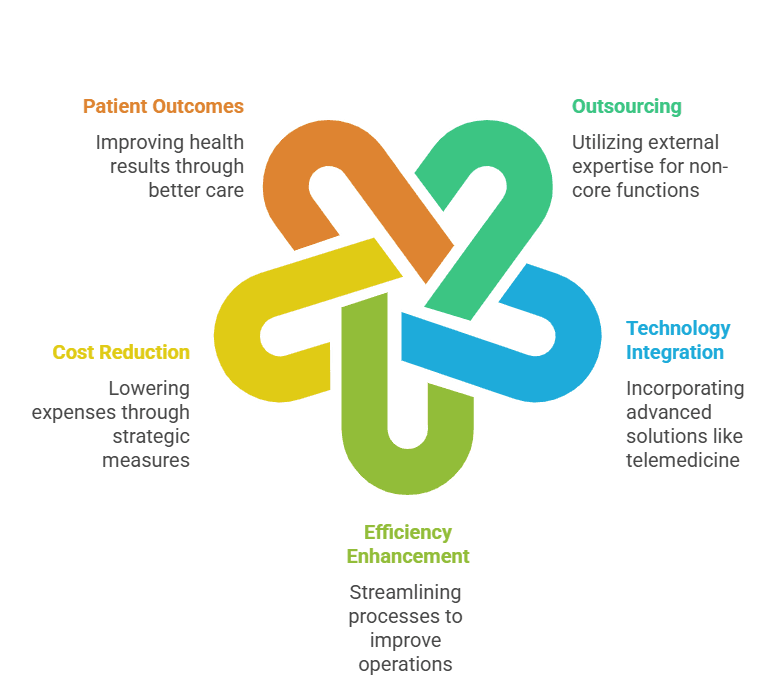On-Demand Outsourcing BPO Services for Healthcare Providers With 24/7 Coverage!
Save up to 70% on staffing costs!
Browse Specialty Staffing ServicesOutsourcing and Technology: Practical Solutions for Healthcare Challenges

Healthcare professionals are raising critical questions about operational inefficiencies that drain clinical time and patient satisfaction. One practitioner captured the frustration perfectly: “there’s a long-standing problem with setting appointments with GPs and psychologists, and complaints that medical receptionists are rude almost anywhere.” The discussion reveals how technology and strategic outsourcing could transform healthcare operations.
The Documentation Time Drain
Healthcare professionals consistently report that administrative documentation consumes valuable clinical hours. One emergency medicine physician explained the scope: “Most documentation could be automated. Standardization of digital referral forms – instead of 5 or 6 different portals for clinicians to refer to different clinics or pathways.”
The problem extends beyond simple paperwork. Clinical staff face fragmented systems that don’t communicate with each other, forcing redundant data entry across multiple platforms. One ICU professional shared a particularly frustrating example: “the ICU i work on at present has the nursing staff write out all the bloods on a little form by the bedside – even though this is available on the computer system! What a waste of precious nursing time.”
This isn’t just inefficiency—it’s clinical time stolen from patient care. When nurses spend time manually transcribing information that already exists digitally, hospitals lose hours of specialized care capacity every single day.
System Integration Nightmares
Healthcare professionals express deep frustration about technology fragmentation. The emergency medicine physician questioned: “One single system for x ray, bloods, letters, notes… or at least systems that talk to each other easily without a hundred clicks. i am unsure why banks and big organizations can do this and healthcare for some reason can not?”
The comparison to banking reveals a critical insight—other industries solved integration decades ago, yet healthcare still operates with disconnected systems. Clinicians waste thousands of hours navigating between platforms, clicking through multiple screens to access information that should be instantly available.
One professional suggested a fundamental shift: “So really we shouldn’t outsource our software – turn it back to inhouse.” The argument highlights concerns about expensive licensing fees for systems that create more problems than they solve, with fixes requiring external vendor support rather than responsive in-house teams.
Appointment Management Failures
The Reddit discussion identified appointment scheduling as a persistent pain point, with medical receptionists often cited as barriers rather than facilitators of care. However, one professional offered important context: “Most of that friction comes from there being too many requests for too few appointments. The assistant that has to say no being virtual doesn’t solve any of that.”
This reveals the core issue—technology alone cannot solve capacity problems. Virtual assistants managing appointment scheduling still face the fundamental constraint of limited provider availability. The rudeness complaints often stem from receptionists exhausted by telling patients “no” repeatedly throughout their day.
Another professional emphasized accountability over technology: “In the context of what you’ve mentioned, outsourcing won’t do anything until we remember how to actually reprimand people for not doing their jobs. A medical receptionist who is rude and doesn’t book properly needs to be pulled up on that. The solution is simply holding them accountable.”
Yet the discussion also acknowledged that patient-side improvements could help. When professionals noted: “When referring patients should be able to let the system know when they are available – meaning much less missed appointments,” they identified how better scheduling technology that captures patient availability upfront could reduce wasted appointment slots.
The EMR Unification Challenge
Healthcare professionals consistently identify electronic medical record fragmentation as a critical barrier to efficient care delivery. One practitioner advocated: “start with a state or country wide EMR that talks to all the other EMRs. Make sure GPs and specialists can access it in their rooms. Make external pathology and radiology can also be accessed.”
The vision is clear—unified systems where every provider can instantly access complete patient records, lab results, and imaging studies regardless of where the patient received care. The professional acknowledged existing efforts: “I know the My EHR is trying to do some of that….just take it to the next level.”
This fragmentation forces patients to repeat their medical history at every new provider, carries physical records between specialists, and delays care while providers request external records. In emergencies, this lack of instant access to medical history can have life-threatening consequences.
AI-Assisted Healthcare: Promise and Reality
Healthcare professionals are developing nuanced perspectives on artificial intelligence in clinical settings. One practitioner noted the potential: “I imagine AI will lead to quick reads of X rays so we miss less lesions from the point of x ray rather than calling patients back in a few weeks.”
The promise of AI catching subtle findings that human eyes might miss could dramatically improve early cancer detection and other critical diagnoses. Rather than waiting weeks for radiologist reads, AI could flag concerning findings immediately, accelerating the diagnostic process.
The key phrase here is “with appropriate clinical supervision.” Healthcare professionals recognize AI as an enhancement tool rather than a replacement for clinical judgment. AI can handle pattern recognition, data processing, and routine decision support, but complex cases still require experienced healthcare professionals.
User Interface Design: The Hidden Time Thief
Poor interface design means healthcare professionals spend extra seconds or minutes on every single interaction with their EMR system. Multiply those inefficiencies across thousands of daily interactions by thousands of healthcare workers, and the cumulative time loss reaches millions of work hours annually.
Healthcare systems often implement powerful software with terrible user interfaces, forcing clinicians to navigate confusing menus, hunt for basic functions, and complete tasks that should require one click but instead demand five or six. Better UI/UX design would immediately increase productivity without requiring new technology or additional staff.
Virtual Care Access Solutions
One healthcare business operator shared practical experience: “Virtual consultations have been a lifesaver for patients who can’t easily travel to clinics. It’s not perfect for everything, but it reduces missed appointments and opens up more options for patients.”
Telemedicine expanded dramatically and revealed both possibilities and limitations. For follow-up appointments, prescription refills, and many common conditions, virtual care works excellently while saving patients travel time and providers office space costs.
Administrative Automation Success
The same healthcare business operator identified administrative tasks as prime automation targets: “Reducing admin headaches: Things like appointment scheduling, reminders, and data management used to overwhelm our staff. With the right tools—and a little outside help—we made these processes much more manageable.”
Automated appointment reminders reduce no-shows significantly. Digital intake forms completed before appointments save front-desk time. Automated eligibility verification prevents billing surprises. These aren’t revolutionary technologies—they’re straightforward automations that many practices still haven’t implemented.
Billing and Revenue Cycle Optimization
Medical billing emerged as another area where outsourcing and technology combine effectively. The healthcare business operator explained: “Billing and insurance: This was one of our biggest bottlenecks. Automating parts of the billing process and outsourcing some of the more complex work to trained professionals made our operations run far more smoothly.”
Medical billing requires specialized knowledge of coding systems, payer requirements, and denial management. Small practices often lack the volume to justify full-time billing specialists, yet billing errors cost them thousands monthly in lost revenue and delayed payments.
Virtual medical billing specialists can handle claims submission, follow up on denials, and manage accounts receivable at a fraction of the cost of hiring local staff. These specialists often have healthcare backgrounds including medical coding certifications and clinical understanding, ensuring accurate claim submission from the start.
The Outsourcing Risk Management Reality
Healthcare professionals also warned about outsourcing pitfalls. One cautioned: “Be careful with outsourcing too much. I’m sure we’ve all seen many examples of this done poorly in health and other areas of the public sector.”
Poor outsourcing implementations happen when organizations hand off functions without proper oversight, choose vendors based solely on cost, or outsource core competencies that should remain in-house. Healthcare systems that outsource their IT departments to the lowest bidder often discover that cost savings disappear when systems break and external vendors take days to respond.
The professional emphasized that accountability matters more than employment structure: “In the context of what you’ve mentioned, outsourcing won’t do anything until we remember how to actually reprimand people for not doing their jobs.”
Strategic Implementation: Technology Plus Expertise
Healthcare professionals recognize that successful operational improvements require both technology and qualified people managing that technology. AI tools need clinical oversight. Automated systems require optimization and exception handling. Virtual assistants work best when they have healthcare backgrounds and understand clinical workflows.
The most successful implementations combine automation with specialized expertise. Virtual medical assistants with clinical education backgrounds can handle patient calls, insurance verification, and care coordination while understanding medical terminology and urgency levels. Medical scribes with healthcare training can prepare charts and manage EHR documentation efficiently.
Technology handles repetitive, rule-based tasks. Trained professionals handle complex cases, exception management, and situations requiring judgment. This hybrid approach maximizes efficiency while maintaining care quality.
Stop Losing Clinical Time to Administrative Inefficiency
Healthcare professionals report that administrative tasks consume hours that should be dedicated to patient care. Instead of hiring expensive local staff or implementing complicated technology alone, practices are discovering that virtual healthcare specialists provide expert service with proper clinical understanding.
30-Day Healthcare Operations Trial
✓ Virtual Medical Assistants – Handle patient calls, scheduling, and follow-ups with healthcare backgrounds including Medical Doctors, Nurses, and PharmDs
✓ Medical Billing & Revenue Cycle Management – Expert claims submission, denial management, and AR follow-up by specialists who understand clinical coding
✓ Medical Scribing & Documentation – Chart preparation and EHR management by professionals who understand clinical workflows
Healthcare professionals with medical backgrounds understand clinical terminology and urgency. HIPAA, SOC 2, and ISO 27001 compliance provides enterprise-level security. Starting at $9.50/hour, under $2,000 monthly vs up to $6,000 local staff costs.
What Did We Learn?
- Outsourcing and technology are not just cost-cutting tools; they are practical solutions to some of healthcare’s biggest challenges.
- We learned that outsourcing helps reduce administrative burdens, streamline billing, and improve efficiency when internal resources are stretched.
- Technology, on the other hand, enables automation of repetitive tasks, enhances patient access through telehealth, and improves accuracy in areas like documentation and diagnostics.
- Together, they free up healthcare professionals to focus on patient care while reducing errors, delays, and operational stress.
What people are Asking?
1. What can outsourcing solve in healthcare?
Tasks like billing, insurance verification, coding, and admin work.
2. How does technology help healthcare?
It automates scheduling, billing, and improves patient access with telehealth.
3. Is outsourcing data safe?
Yes, if vendors follow HIPAA and strict data security standards.
4. Can virtual assistants help clinics?
Yes, they manage calls, appointments, and reminders efficiently.
5. What’s better—outsourcing or tech?
Both work best together: outsourcing brings expertise, tech adds efficiency.
Disclaimer
For informational purposes only; not applicable to specific situations.
For tailored support and professional services
Please contact Staffingly, Inc. at (800) 489 5877
Email: support@staffingly.com
About This Blog: This Blog is brought to you by Staffingly, Inc., a trusted name in healthcare outsourcing. The team of skilled healthcare specialists and content creators is dedicated to improving the quality and efficiency of healthcare services. The team passionate about sharing knowledge through insightful articles, blogs, and other educational resources.
 Book a Demo to Build Your Team Today!
Book a Demo to Build Your Team Today!


 Read Case Studies
Read Case Studies 



 Virtual Medical Assistants
Virtual Medical Assistants



